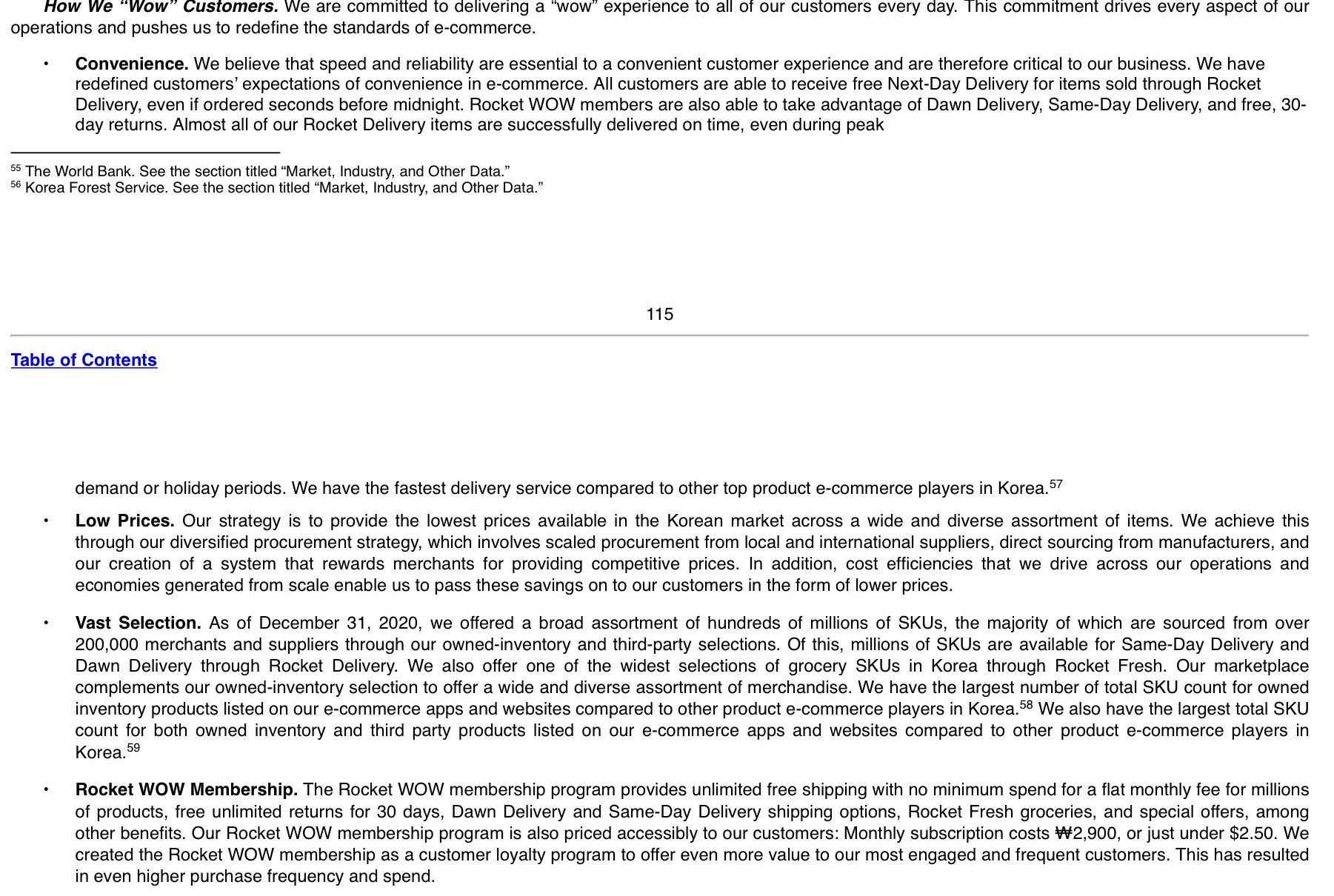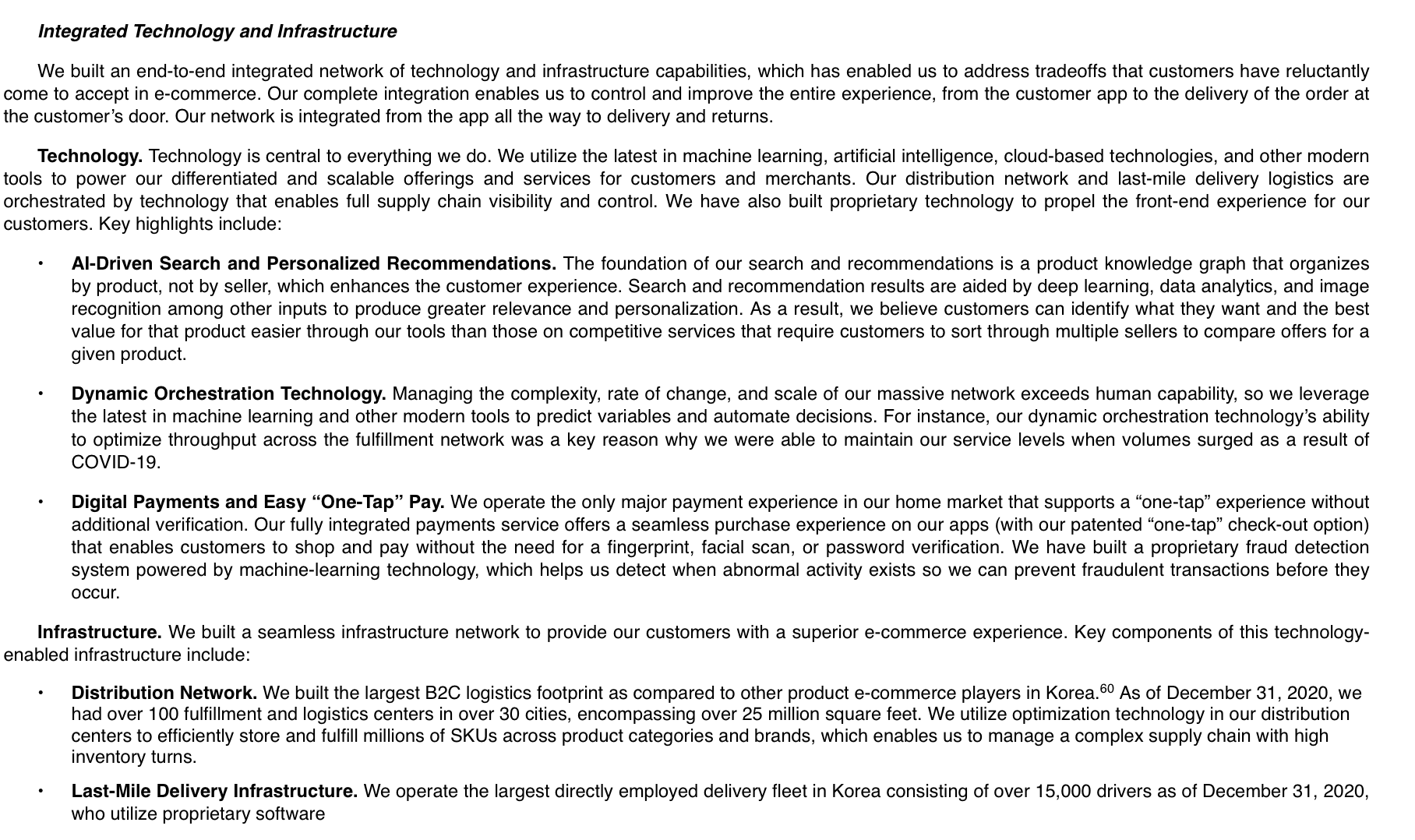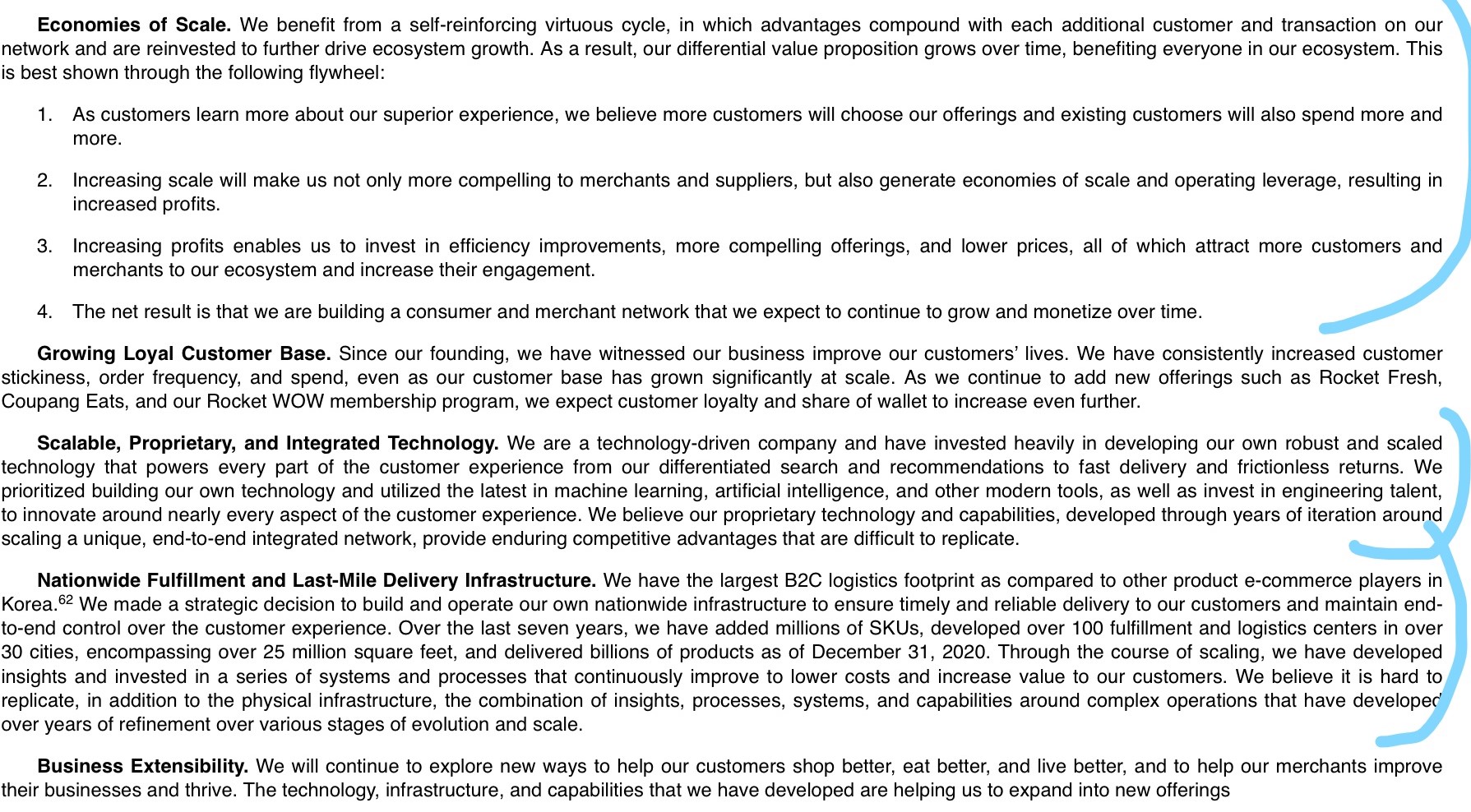The latest big tech IPO out of Asia is Coupang, a likely $50B listing called the “Amazon of South Korea”. More on that annoying phrase in a moment.
But first, let’s take a moment to be thankful for being in the Asia tech space. It’s just awesome. It’s just one cool company after another. Last month it was Kuaishou (+$160B IPO). Before that it was Ant Financial (sort of). And JD Logistics has just filed for IPO in Hong Kong. It’s a constant stream of top-tier tech companies. And these companies are far more dynamic than glacial-speed companies like Airbnb, Facebook and Twitter.
An Introduction to Coupang
Coupang was founded in 2010 by Bom Kim, a Harvard Business School drop-out. It began as a group buying site and evolved into a more traditional online retailer. Focused only on South Korea.
South Korea has +51M people, with a GDP per capita of $44k. The geography is relatively small and is 60% mountainous. So 81% of the population lives in cities. It’s a highly dense urban country, which common in Asia. And it has a fragmented express delivery market.
The first thing that jumps out when reading the Coupang IPO filing is how crisp and clear their strategy is. Here is how the company describes its value proposition.

Note how specific the language is. This contains a description of a marketplace platform.
- For consumers, they offer “superior selection, convenience and low prices”.
- For merchants, they help “improve and grow and their businesses.”
And, like Alibaba and Ant Group, they seek to grow the activity on their platform by continually adding value to their users. They are focused on sustained innovation to keep their users coming and being active. You can see this in their language. They are striving “to create ever-improving experiences at lower prices”. That’s great. And they are doing this by “innovations around our end-to-end integrated network of technology and infrastructure, new offerings and effective merchant solutions.”
But, like JD, they are mostly focused on consumers. They have a marketplace platform but they are mostly a retailer. And their language speaks to this very well. Here is their strategy for this.

That is some well-thought out language. They are consumer-centric and want to continually “Wow” their customers. Plus they have some great adjectives. “Dawn delivery” and “Rocket Delivery” are cool terms.
Here is their description for merchants, which is pretty standard but solid.

And really their biggest strategy is in “Integrated Technology and Infrastructure”. This is the most important part of what they are doing.


All of that is just really clear strategy thinking. With some good adjectives.
Hello Profitless Growth and Operating Leverage
One of the reasons Coupang is getting a lot of attention right now is its growth rate. Their revenue for 2020 was $11.97B, up 91% from 2019. And that was up 55% from 2018. Investors love that of course.
And I recently talked about how to think of revenue scale in software vs. platform business models in my podcast on revenue scale vs. operating leverage. But I also argued that operating leverage was just as important as revenue growth. How does the operating margin change with changing revenue?
Well, guess what Coupang’s digital platform, IT spending and logistics network have in common?
Lots of operating leverage.
The company has big revenue growth but is also primed for operating margin expansion. They could become more and more profitable as they grow in revenue (if they choose). Lots of fixed costs. Lots of efficiencies. And this also creates a formidable barrier to entry. Note how they they talk about their strengths. I have highlighted the areas that look like a focus on operating leverage.

A final point on this.
Today, Coupang is doing a profitless growth strategy. Similar to JD, which I wrote about here. For the near future, I expect them to take their online cost advantages (versus physical retailers) and pass those savings on to consumers as lower prices. That will expands their marketshare and help them grow, which further increases their scale and purchasing economies. And further lowers costs. A virtuous cycle (sort of). Plus they will flood money into infrastructure and R&D, which should also lower costs and improve the user experience over time.
So I’m not expecting the operating margins to increase in the near-term.
This All Looks Like JD, Circa 2015
JD, like Coupang, has always been focused on consumers first and foremost. It was founded as a retailer, not a marketplace like Alibaba. It would later add a marketplace platform but it has always been an online retailer at its core. And it has positioned itself as the retailer for high quality, authentic (i.e., not fake) goods.
JD began building its own logistics network in-house in 2007. This was a bold move by CEO Richard Liu as it would be a massive expenditure over time. Covering China with warehouses and delivery people was a huge project. But logistics and delivery by 3rd party companies was the biggest complaint by consumers. Even today, China’s logistics is still highly fragmented and inefficient. According to JD Logistics IPO filing, China’s outsourced logistics industry today is approximately 7T RMB per year. And JD, as the largest source of integrated logistics and supply chain today, is only 2% of the market. The top 10 companies collectively have 8%.
Today, JD operates 6 synergistic logistics networks.
- Warehouse network. They operate +800 warehouses plus 1,400 cloud warehouses (third parties own and operate these but JD provides the software, brand and connection to the core network).
- Line-haul transportation network. This is their fleet of +7,500 trucks and vehicles. Plus +200 sorting centers. This is the system for moving items physically.
- Last-mile delivery network. This is +7,200 delivery stations and +190,000 delivery people. All in-house although they do access other capacity as needed.
- Bulky item logistics network. This is 86 warehouses and 102 sorting centers for bulky and heavy items (typically furniture and home appliances).
- Cold chain logistics network. 87 warehouses and +2,000 vehicles for fresh produce and other perishable items.
- Cross-border logistics network.
Along the way, JD made several other major strategic moves:
- Expansion From Retailer to Marketplace Business Model. JD added SMEs and other merchants as a second user group and began expanding their GMV via marketplace. Today, it is about 50/50 retailer vs. marketplace model.
- Guaranteed Same Day or Next Day Delivery: JD began offering 211 (also called 11-11) delivery. If you order by 11pm at night, you get the order the next morning. If you order by 11am, you get it that day. This turned out to be a powerful move in terms of serving consumers and resetting their expectations. This sounds exactly like the Coupang’s Rocket Delivery.
- Expansion to a Digital Conglomerate: In 2014, JD and Tencent formed a strategic partnership in ecommerce. JD acquired Tencent’s fledgling ecommerce platforms and WeChat began to direct traffic to JD. This moved them beyond a pure player ecommerce company to being part of a larger ecosystem.
- Expansion into Physical Retail: In 2016, JD formed a strategic partnership with Walmart China. They goal was to combine physical and digital assets. And they began integrating their inventory and data.
- Externalize Logistics: In 2017, JD began externalizing their logistics and fulfilment capabilities. They began selling these services to corporate customers, with JD being the largest customer. This became JD Logistics, which is now going public.
You can see Coupang is already doing 1 and 2. I am looking for signs of 3-5. They could easily partner with Line / Naver the same way JD partnered with WeChat. Or they could expand into these spaces themselves like they have already moved into food delivery. Note the last bullet point in their stated growth strategy.

A move into physical retail would be interesting. New retail / online-merge-offline is the frontier of groceries, fashion and department stores.
But it is #5 that is the most likely. In 2017, JD began selling its logistics services to other businesses. This is identical to what AWS did at Amazon. Externalizing a core capability makes a company more dynamic and competitive. And it can get you additional scale.
***
Overall, Coupang is an impressive company with a crystal-clear, compelling strategy. And you probably know that I like ecommerce and marketplace companies a lot.
A final question is: How big is the opportunity?
Coupang is the Mini-JD of South Korea
I’m getting tired of the comparison to Amazon. Coupang has nothing to do with Amazon. And South Korea is not like the US economy. At all.
South Korea is developed Asia. It’s appropriate comparisons are Japan, Taiwan, Hong Kong, Singapore and parts of Mainland China. It has very little in common with North America. And, by the way, Amazon is not really anywhere in Asia, except for Japan.
To me, Coupang looks a lot like JD around 2015. And for a single China “city cluster”. I consider it a mini-JD.

The above map shows China as a series of city clusters. And that is pretty accurate. You really don’t see infrastructure seamlessly connecting each part of the country, like say in the United States. You don’t see an integrated continental economy. That is likely the future but not yet the present.
What you see today is a series of “clusters” – with each cluster containing 20-30 cities and typically over 60 million people. For example, Beijing / Tianjin in the North is actually a cluster of 28 cities – all increasingly interconnected by roads, rail and other new infrastructure. Qingdao, well known for its beer, is actually part of a 35-city cluster.
These +60M person clusters are the vast majority of the economy. China today has more than 20 of these clusters. And each is about the size of a large European country (closer to France and Germany than Greece or Austria). According to government plans, China’s main clusters will cover 80% of the GDP and 60% of the population.
The big urbanization and infrastructure trends are mostly about building clusters. Much of the highly publicized high-speed rail and other infrastructure projects are about creating clusters. It is about making it possible for people and goods to travel cheaply and quickly within a cluster. A key metric to watch is the logistics cost within clusters, which has been falling fast. Outside it is quite high.
A more developed cluster (like Beijing or Shanghai) is a pretty good model for South Korea (which has 51M people) and for Coupang. You see similar urban density. Although GDP per capita varies pretty good depending what demographic you are looking at.
That is about where I size this opportunity. Coupang as a mini-JD for one major city cluster.
That’s it for today. Cheers, jeff
——–
I write, speak and consult about how to win (and not lose) in digital strategy and transformation.
I am the founder of TechMoat Consulting, a boutique consulting firm that helps retailers, brands, and technology companies exploit digital change to grow faster, innovate better and build digital moats. Get in touch here.
My book series Moats and Marathons is one-of-a-kind framework for building and measuring competitive advantages in digital businesses.
This content (articles, podcasts, website info) is not investment, legal or tax advice. The information and opinions from me and any guests may be incorrect. The numbers and information may be wrong. The views expressed may no longer be relevant or accurate. This is not investment advice. Investing is risky. Do your own research.

